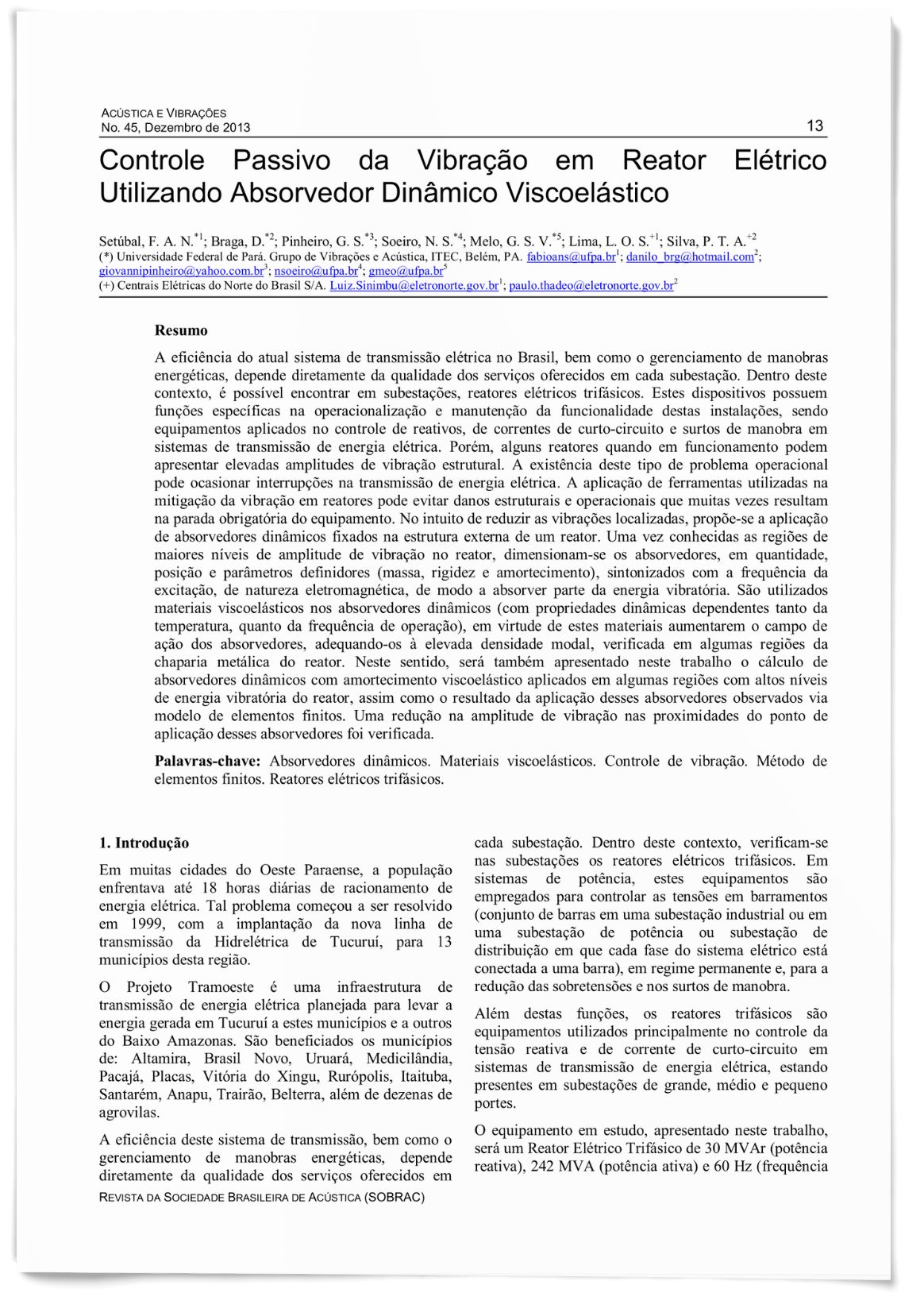Controle Passivo da Vibração em Reator Elétrico Utilizando Absorvedor Dinâmico Viscoelástico
DOI:
https://doi.org/10.55753/aev.v28e45.147Palavras-chave:
Absorvedores dinâmicos, Materiais viscoelásticos, Controle de vibração, Método de elementos finitos, Reatores elétricos trifásicosResumo
A eficiência do atual sistema de transmissão elétrica no Brasil, bem como o gerenciamento de manobras energéticas, depende diretamente da qualidade dos serviços oferecidos em cada subestação. Dentro deste contexto, é possível encontrar em subestações, reatores elétricos trifásicos. Estes dispositivos possuem funções específicas na operacionalização e manutenção da funcionalidade destas instalações, sendo equipamentos aplicados no controle de reativos, de correntes de curto-circuito e surtos de manobra em sistemas de transmissão de energia elétrica. Porém, alguns reatores quando em funcionamento podem apresentar elevadas amplitudes de vibração estrutural. A existência deste tipo de problema operacional pode ocasionar interrupções na transmissão de energia elétrica. A aplicação de ferramentas utilizadas na mitigação da vibração em reatores pode evitar danos estruturais e operacionais que muitas vezes resultam na parada obrigatória do equipamento. No intuito de reduzir as vibrações localizadas, propõe-se a aplicação de absorvedores dinâmicos fixados na estrutura externa de um reator. Uma vez conhecidas as regiões de maiores níveis de amplitude de vibração no reator, dimensionam-se os absorvedores, em quantidade, posição e parâmetros definidores (massa, rigidez e amortecimento), sintonizados com a frequência da excitação, de natureza eletromagnética, de modo a absorver parte da energia vibratória. São utilizados materiais viscoelásticos nos absorvedores dinâmicos (com propriedades dinâmicas dependentes tanto da temperatura, quanto da frequência de operação), em virtude de estes materiais aumentarem o campo de ação dos absorvedores, adequando-os à elevada densidade modal, verificada em algumas regiões da chaparia metálica do reator. Neste sentido, será também apresentado neste trabalho o cálculo de absorvedores dinâmicos com amortecimento viscoelástico aplicados em algumas regiões com altos níveis de energia vibratória do reator, assim como o resultado da aplicação desses absorvedores observados via modelo de elementos finitos. Uma redução na amplitude de vibração nas proximidades do ponto de aplicação desses absorvedores foi verificada.
Referências
SOEIRO, N. S., et. al. (2000), Calculation of Eletromagnetic-mechanic-acoustic behavior of a squirrel-cage induction motor, Proceedings of the 2nd International Seminar on Vibrations and Acoustic Noise of Electric Machinery, Lodz (Polônia), 01-03 de junho.
ATALLA, N. and BERNHARD, R. J. (1994), Review of Numerical Solutions for Low-Frequency Structural-Acoustic Problems, Applied Acoustics 43, 271-294. doi: 10.1016/0003-682X(94)90050-7 DOI: https://doi.org/10.1016/0003-682X(94)90050-7
VLAHOPOULOS, N., RAVEENDRA, S. T. (1999), Numerical implementation and applications of a coupling algorithm for structural-acoustic models with unequal discretization and partially interfacing surfaces, Finite Elements in Analysis and Design 32, 257-277.v DOI: https://doi.org/10.1016/S0168-874X(99)00008-6
COYETTE, J. P. (1999), The use of finite-element and boundary-element models for predicting the vibro-acoustic behaviour of layered structures, Advances in Engineering Software 30,133-139. doi: /10.1016/S0965-9978(96)00041-5 DOI: https://doi.org/10.1016/S0965-9978(96)00041-5
SOEIRO, N. S., Uma metodologia de modelagem vibro-acústica de caixa de engrenagem de uso veicular. 2000. 237 f. Tese (Doutorado em Engenharia Mecânica). Universidade Federal de Santa Catarina, Florianópolis. 2000.
ALTSTADT, E. and WEISS, F. P. (1999), Finite element based vibration analysis of WWER-440 type reactors. Annals of Nuclear Energy 26,1037 - 1052. DOI: https://doi.org/10.1016/S0306-4549(99)00002-X
JOHNSON, C. D., Design of damping Systems, 2001.
BAVASTRI, C. A., Redução de Vibrações de Banda Larga em Estruturas Complexas por Neutralizadores Viscoelásticos, Tese de Doutorado, UFSC, 1997.
DEN HARTOG, J. P., Mechanical Vibrations, Dover Publications, 1985.
ABNT NBR 7569. Reatores para sistema de potência - Método de ensaio. 1982.

Publicado
Como Citar
Edição
Seção
Licença
Copyright (c) 2013 Acústica e Vibrações

Este trabalho está licenciado sob uma licença Creative Commons Attribution-NonCommercial-ShareAlike 4.0 International License.




